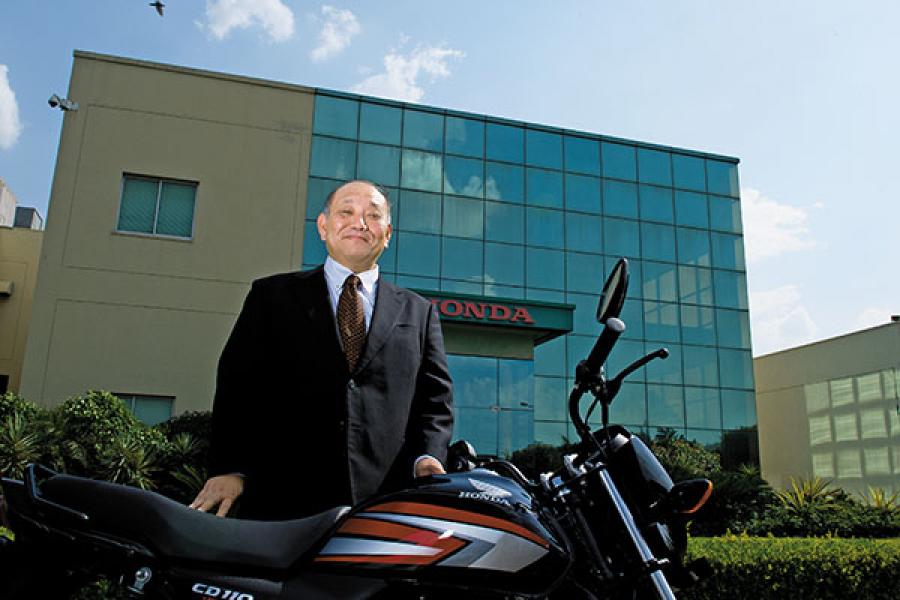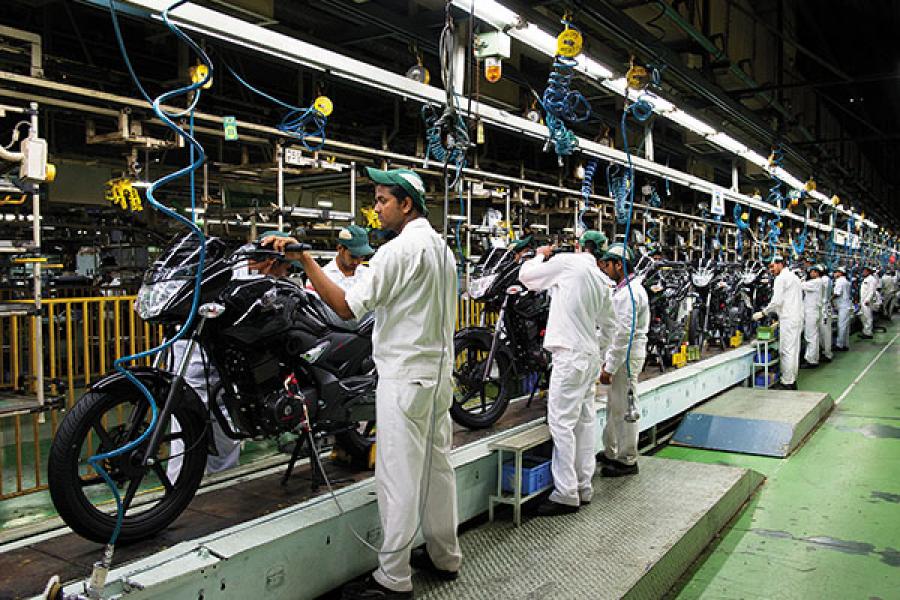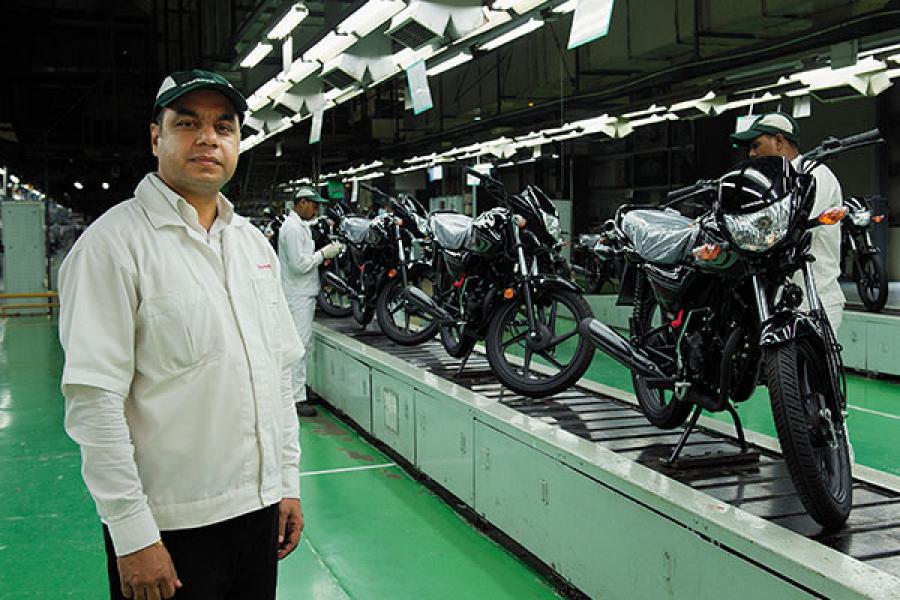
The Master Tactician: Honda's Keita Muramatsu is keen on racing ahead in India
Three years ago, Keita Muramatsu moved from Honda's motorsports division to take over the auto company's two-wheeler operations in India. He may have left the world of professional racing behind, but he's on course to take the lead in India
Award: Best CEO-Multinational
Keita Muramatsu
President and CEO, Honda Motorcycle and Scooter India (HMSI)
Age: 54
Interests outside of work: An accomplished drummer, he plays the instrument at company gatherings
Why they won this award: For consistently increasing HMSI’s share in the two-wheeler market. While the Activa scooter is the largest-selling two-wheeler in India, HMSI has made a promising start with its entry-level motorcycles
Ask Keita Muramatsu to rate his performance and pat comes the reply, “S for superb.” After spending three years in India, the 54-year-old president and chief executive of Honda Motorcycle and Scooter India (HMSI) has every reason to be proud of his company’s performance. Sales have doubled from 1.6 million scooters and motorcycles a year when he took over in April 2011 to 3.7 million units in the year ending March 2014, beating the industry growth rate by two times. It is, by far, the leader in the scooter segment and has made a strong showing in the hyper-competitive market for motorcycles.
It is also the manner in which Muramatsu has gone about increasing HMSI’s market share that has caught the attention of industry watchers. A master tactician with an unexpected understanding of the Indian market, he has planned for a long and bruising fight with motorcycle leader Hero MotoCorp and smaller rivals, Bajaj Auto and TVS Motor Company. “When I came to India, we had a lot of back orders especially for scooters. My immediate challenge was to get production up. Later, we focussed on expanding our dealer base,” says Muramatsu.
Surjit Arora, an analyst who tracks auto for brokerage firm Prabhudas Lilladhar, describes HMSI’s approach to India as a measured one, and this has allowed the company to lay a strong foundation for the future. “I see HMSI carving out a 20 percent share in the motorcycle market in the next five years. It will, of course, maintain its leadership position in the scooter market,” he says.
Some numbers first. The largest selling two-wheeler in the country is a scooter—and not a motorcycle— and it is here that Honda has a stranglehold. Its ungeared Activa scooter, launched in 2001 to jumpstart a sluggish market, raced ahead of its rivals by such a wide margin that company officials say there really is no competition for them in this segment. Success has not stopped Muramatsu from improving on the model and plotting ways to increase its popularity: At 1.95 lakh units a month, the Activa scooter outperforms India’s fastest-selling motorcycle, Hero MotoCorp’s Splendor, by 30,000 units.
While the two-wheeler market has grown annually by a subdued 9 percent over the last three years, the scooter market has clocked a growth rate in excess of 30 percent for the same period. And it is here that HMSI has managed to make the most of its bestselling product.
Muramatsu would like nothing more than to replicate this success in the motorcycle segment. HMSI has been aggressively marketing its entry-level motorcycles, Dream Yuga and Dream Neo, which have begun to make their presence felt in the last one year, after they were launched in May 2012 and April 2013 respectively. “I want to increase the number of units HMSI sells to 4.5 million by 2015,” says Muramatsu. If he does that, HMSI would have grown at 21 percent, or twice the market growth rate.
From Formula One to rural India
Muramatsu’s Indian assignment is a far cry from his previous position at Honda. Before he was appointed chief executive of the Indian two-wheeler business, he was the general manager of Honda Motor Company’s motorsports division, and was responsible for its performance in car rallies and water sports (Honda manufactures motorboards, jet skis like the Honda AquaTrax and personal water craft). But he seems as much at ease in India as he was in the Formula One circuit. This is a different kind of race, one that will pit Honda against its former partner Hero MotoCorp, and one that, now, is beginning to unfold in the rural arena.
Muramatsu came to India a year after the parent companies, Honda and Hero Group, dissolved their 26-year-old joint venture, Hero Honda, in 2010. It is believed that Honda had asked for the dissolution of the JV as the two companies were now competing on similar products. Apart from wanting to focus on its wholly-owned Indian subsidiary, HMSI, which was founded in 1999, the Japanese company was getting ready to manufacture 100cc bikes that would be in direct competition with Hero’s models. As per the terms of the dissolution, the Japanese company would continue to supply technology to Hero MotoCorp till this year.
Muramatsu has a two-fold agenda for HMSI: Maintain and better its performance in the scooter segment, and take the lead in the motorcycle market. When HMSI started its India operations, the scooter market was comatose: Consumer preference had started shifting to motorcycles by the late 1990s. This had caught hitherto industry leader Bajaj sleeping, leaving HMSI to run away with a large slice of the market with its hugely popular Activa.
The auto company, however, was not ready to give up on the lethargic scooter market either. After all, it had an ace up its sleeve: The ungeared scooter. With a mileage of over 50 km per litre, the first model of Activa became a hit with urban Indians. And HMSI started concentrating on cities where the population was more than a million. They’ve stuck to this strategy for 10 years now.
Muramatsu has adopted a different tactic for HMSI’s new range of motorcycles, Dream Yuga and Dream Neo. When the company launched these entry-level, mass-selling 100cc motorcycles in 2012, he knew that he had to take them to rural and semi-urban India. And he did just that.
Last year, when he visited Alwar in Rajasthan, villagers told him that they loved Honda’s motorcycles, but couldn’t buy them because there were no dealers in their villages. Travelling long distances to a township to service a bike meant lost wages. Muramatsu may have used a translator to communicate with the Alwar residents, but he was listening carefully.
HMSI is now working on an aggressive plan to double its dealer network across the country, especially in rural and semi-urban markets. This will take it to places where its erstwhile partner, Hero MotoCorp, has a strong presence. But Muramatsu appears to be prepared for the confrontation.
According to Arora, Honda’s motorcycles have been received well in the market. “But most of the share it has taken away is from Bajaj, and not from Hero,” he says. In the years to come, HMSI will have its task cut out in displacing Hero’s Splendor and Passion, which are the world’s largest-selling motorcycles.
This is something Muramatsu is cognisant of, and he’s banking on Honda’s reputation for superior technology, except that the innovation is coming out of HMSI’s headquarters in Manesar, Haryana.
In 2012, the company re-engineered its products to enhance fuel efficiency. “If we had consulted Japan, they would have asked us to go in for fuel injections [an efficient delivery system where fuel is introduced under pressure directly into the internal combustion engine]. But that is very expensive and people here would not pay a premium [for it],” he says. The Indian team had to come up with a more cost-efficient technology to increase mileage.
One of the first things Muramatsu had done when he took over at HMSI was to organise departments so that no team was working in isolation. People from engineering, sales, marketing and research and development now operate out of the same building in Manesar. “With teams constantly interacting with each other, issues were ironed out at the planning stage itself, rather than R&D preparing something and marketing rejecting it because of high costs,” says Yadvinder Singh Guleria, vice president, sales and marketing, HMSI.
The set-up fostered a collaborative approach to work, which helped HMSI develop a new technology to inject fuel into the carburettor at a fraction of the cost. Christened Honda Eco Technology (HET), it was introduced in the newer models of Dream Yuga and Dream Neo—without an increase in price. It was also factored into Activa, taking its fuel efficiency to 55 km per litre.
Other innovations were also made incrementally. On the same tour of Rajasthan, Muramatsu noticed that as many as four people travelled together on motorcycles, and Hero had already increased the length of seats on its bikes. Honda did the same.
Apart from these changes, Muramatsu has also streamlined HMSI’s operation model from production right down to the dealership level.
Small changes, big gains
In April 2011, HMSI had just commenced production from its second plant in Tapukara in Alwar district. While it met the existing requirements of the market, Muramatsu knew he had to plan for several years in advance, especially if he wanted more Honda two-wheelers on India’s roads.
While mapping his strategy, he realised that both of HMSI’s manufacturing facilities were in north India—the other plant is in Manesar—and the cost of transporting scooters and motorcycles to different parts of the country was high. “If this added even Rs 1,000 to the sale price, it was an expense that customers could do without,” says Muramatsu. He immediately began scouting for potential factory sites in south India, and zeroed in on Bangalore. The new plant became operational in 2013, and helped strengthen HMSI’s presence in the southern states.
Muramatsu also acclimatised himself to logistical challenges such as getting component vendors to open operations near HMSI’s plants. Almost all auto companies outsource the manufacturing of some, if not all, of their components, but vendors have to be motivated by large volumes to set up operations near the company’s factory. Honda decided to go for broke. The result: With an output of 1.8 million two-wheelers a year, the Bangalore plant is the largest in the world. Since then, Honda has announced its plan to build a fourth factory near Ahmedabad in Gujarat.
Another problem HMSI faced was the lack of skilled manpower at the dealership level. Setting up a plant with 4,000-5,000 workers is relatively easy and straightforward: Recruit them, train them and they are on the job. But it’s trickier with dealers who, more often than not, are the face of the company, and interact directly with customers.
The way it works is that each dealer has a number of bays staffed by two technicians. They are usually hired by the dealer, but go through a brief training process with the auto company. When an owner brings in a two-wheeler, the technicians make a note of the problem, fix it, and service the vehicle (oil change, brake check). In an efficient set-up, the process usually takes no more than an hour, and the owner is on his way. But if the dealer is tardy, customers will almost certainly desert the brand.
Maintaining efficiency at the dealership and servicing level is a challenge, especially in India, where consumers have a high dependency on two-wheelers, and where motorcycles and scooters serve a dual purpose of business and personal use. For customers, time is money and delays mean losses.
Most auto companies prescribe minimum general standards, and dealers have to adhere to them. But as volume increased, dealers were finding it difficult to get skilled manpower. Muramatsu stepped in to plug this hole. In 2011, HMSI needed to train 10,000 technicians a year. Soon, that number became 30,000. “We realised that the existing way wasn’t working. Technicians from the south would spend two days [travelling by train] just to get to the HMSI’s sole training centre in Manesar,” says Guleria.
Muramatsu decided to decentralise the training process which now takes place zone-wise. HMSI even tweaked its technician recruitment process by looking beyond the conventional feeder schools and including people from a variety of backgrounds. As its production lines get ready to churn out another million two-wheelers by the end of FY15, HMSI will have to prepare an army of technicians. (It aims to train 37,000 people this year.) On their own, the measures that Muramatsu has introduced—building a new factory and streamlining dealership outlets—may seem minor. But together, they have helped HMSI expand its operations smoothly and swiftly.
These days, Muramatsu is busy planning ways to make the most of the festive season. And he’s hit upon a solution to a problem that had perplexed him from day one: Every year, sales spike around Diwali, but HMSI is usually ill-prepared to handle the rush. “We only produce a certain amount every day, and can’t take production up due to the seasonality in demand,” he says. This resulted in lost sales as potential customers sought out competitors.
But this Diwali, Muramatsu has a battleplan. HMSI started stockpiling scooters and motorcycles months in advance. Dealers have also been told to make arrangements to store more two-wheelers. It has lined up more trucking companies to ensure that its products reach them on time. If he can see this festive season off successfully, Muramatsu says that one of his “last big challenges” will be taken care of.
HMSI, in its time in India, has always been a strong player. And with Muramatsu at its helm, it is preparing to become the country’s number one two-wheeler company in the not too distant future. This will be achieved unhurriedly, but solidly. Because Muramatsu, who smiles jovially before answering each question, has worked long enough in the industry to know that success is an incremental journey, never a giant leap.
(This story appears in the 17 October, 2014 issue of Forbes India. To visit our Archives, click here.)


















